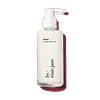What's inside
What's inside
 Key Ingredients
Key Ingredients

No key ingredients
 Benefits
Benefits

 Concerns
Concerns

 Ingredients Side-by-side
Ingredients Side-by-side

Carthamus Tinctorius Seed Oil
MaskingRicinus Communis Seed Oil
MaskingCaprylic/Capric Triglyceride
MaskingParfum
MaskingRosa Canina Fruit Oil
EmollientAdesmia Boronioides Flower/Leaf/Stem Oil
MaskingSimmondsia Chinensis Seed Oil
EmollientLimnanthes Alba Seed Oil
Skin ConditioningSqualane
EmollientMoringa Oleifera Seed Oil
EmollientTetrahexyldecyl Ascorbate
AntioxidantEclipta Prostrata Extract
Skin ConditioningMelia Azadirachta Flower Extract
Skin ConditioningMelia Azadirachta Leaf Extract
Skin ConditioningVegetable Oil
Skin ConditioningCurcuma Longa Root Extract
MaskingMelia Azadirachta Bark Extract
AntimicrobialCorallina Officinalis Extract
Skin ConditioningOcimum Sanctum Leaf Extract
Skin ConditioningOcimum Basilicum Flower/Leaf Extract
TonicTocopherol
AntioxidantLinoleic Acid
CleansingLecithin
EmollientPhytosteryl Canola Glycerides
Skin ConditioningOleic Acid
EmollientPalmitic Acid
EmollientStearic Acid
CleansingTriolein
Skin ConditioningBenzotriazolyl Dodecyl P-Cresol
UV AbsorberHydroxycitronellal
PerfumingCarthamus Tinctorius Seed Oil, Ricinus Communis Seed Oil, Caprylic/Capric Triglyceride, Parfum, Rosa Canina Fruit Oil, Adesmia Boronioides Flower/Leaf/Stem Oil, Simmondsia Chinensis Seed Oil, Limnanthes Alba Seed Oil, Squalane, Moringa Oleifera Seed Oil, Tetrahexyldecyl Ascorbate, Eclipta Prostrata Extract, Melia Azadirachta Flower Extract, Melia Azadirachta Leaf Extract, Vegetable Oil, Curcuma Longa Root Extract, Melia Azadirachta Bark Extract, Corallina Officinalis Extract, Ocimum Sanctum Leaf Extract, Ocimum Basilicum Flower/Leaf Extract, Tocopherol, Linoleic Acid, Lecithin, Phytosteryl Canola Glycerides, Oleic Acid, Palmitic Acid, Stearic Acid, Triolein, Benzotriazolyl Dodecyl P-Cresol, Hydroxycitronellal
Water
Skin ConditioningHelianthus Annuus Seed Oil
EmollientHamamelis Virginiana Water
AstringentAloe Barbadensis Leaf Juice
Skin ConditioningGlyceryl Stearate Citrate
EmollientWater, Helianthus Annuus Seed Oil, Hamamelis Virginiana Water, Aloe Barbadensis Leaf Juice, Glyceryl Stearate Citrate, Simmondsia Chinensis Seed Oil, Crocus Sativus Stigma Water, Caprylyl Glycol, Glycerin, Sodium Acrylates/C10-30 Alkyl Acrylate Crosspolymer, Sodium Dehydroacetate, Curcuma Longa Root Extract, Parfum
Ingredients Explained
These ingredients are found in both products.
Ingredients higher up in an ingredient list are typically present in a larger amount.
Curcuma Longa Root Extract is from the spice, turmeric. Besides being a healthy and delicious spice, turmeric also has plenty of skincare benefits. It has anti-inflammatory, antioxidant, and anti-microbial properties.
Turmeric contains curcumin, an antioxidant. Antioxidants help neutralize unstable free-radical molecules. Free-radical molecules may damage your skin's cells and DNA. Curcumin may help with anti-aging.
Curcumin also has anti-inflammatory properties and can help soothe skin and reduce irritation. On top of that, curcumin has been shown to help prevent hyperpigmentation from sun damage.
The anti-microbial property of turmeric can make it effective in treating acne. This property has also been shown to help regulate the production of sebum.
Learn more about Curcuma Longa Root ExtractParfum is a catch-all term for an ingredient or more that is used to give a scent to products.
Also called "fragrance", this ingredient can be a blend of hundreds of chemicals or plant oils. This means every product with "fragrance" or "parfum" in the ingredients list is a different mixture.
For instance, Habanolide is a proprietary trade name for a specific aroma chemical. When used as a fragrance ingredient in cosmetics, most aroma chemicals fall under the broad labeling category of “FRAGRANCE” or “PARFUM” according to EU and US regulations.
The term 'parfum' or 'fragrance' is not regulated in many countries. In many cases, it is up to the brand to define this term.
For instance, many brands choose to label themselves as "fragrance-free" because they are not using synthetic fragrances. However, their products may still contain ingredients such as essential oils that are considered a fragrance by INCI standards.
One example is Calendula flower extract. Calendula is an essential oil that still imparts a scent or 'fragrance'.
Depending on the blend, the ingredients in the mixture can cause allergies and sensitivities on the skin. Some ingredients that are known EU allergens include linalool and citronellol.
Parfum can also be used to mask or cover an unpleasant scent.
The bottom line is: not all fragrances/parfum/ingredients are created equally. If you are worried about fragrances, we recommend taking a closer look at an ingredient. And of course, we always recommend speaking with a professional.
Learn more about ParfumThis oil comes from the seeds of the desert shrub called Jojoba. It is more commonly known as jojoba oil, a non-comedogenic oil.
Jojoba oil does not contain fragrance and has many fatty-acids, making it a great soothing ingredient.
It also contains Vitamin E, a great moisturizing ingredient. Vitamin E is also an antioxidant and protects your skin against oxidative damage.
This ingredient humectant properties, meaning it helps draw moisture from the air. This helps keep your skin hydrated.
While jojoba has antibacterial properties, it is only able to kill some strains of bacteria.
Studies also show it helps in wound healing. In fact, Indigenous cultures have used jojoba as a moisturizer and to help treat burns for centuries.
Fun fact: Jojoba oil similar to natural human skin sebum, so it has a great effect on dry skin. It is also promising with helping to regulate sebum production.
Due to its fatty acid content, Jojoba oil may not be fungal acne safe. We recommend speaking with a professional if you have any concerns.
Learn more about Simmondsia Chinensis Seed Oil